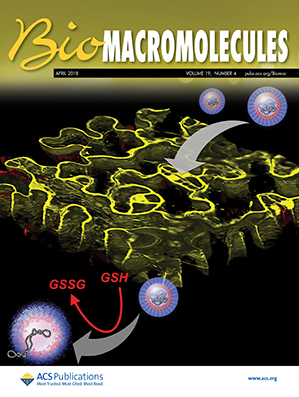Glycerol-Based Polymer to Improve the Cellular Uptake of Liposomes
IF 5.4
2区 化学
Q1 BIOCHEMISTRY & MOLECULAR BIOLOGY
引用次数: 0
Abstract
Nanomedicines modify the pharmacology of pharmaceutical ingredients, but most require cell internalization to deliver their payloads. Hence, modifying the surface properties of nanomedicines can improve their interactions with cells and modulate their pharmacology. Herein, we devised a polymer that increases how nanomedicines are internalized by cells. The alkylated poly(monoglycerol acrylate) (PMGA) polymer was synthesized by reversible addition–fragmentation chain-transfer (RAFT) polymerization with a terminal double 18-carbon moiety that allows its anchoring on the surface of liposomes. PMGA-decorated liposomes are internalized more efficiently in immune cells, compared to formulations without the polymer. Using inhibitors of internalization pathways, we established that PMGA promotes cell entry by the fast endophilin-mediated endocytosis (FEME). In comparison, noncoated control liposomes were mostly internalized by clathrin-mediated endocytosis. This work highlights the potential of PMGA to increase the internalization of nanomedicines by immune cells, and target a novel internalization pathway.
- Download: Download high-res image (274KB)
- Download: Download full-size image
甘油基聚合物提高脂质体的细胞摄取。
纳米药物改变药物成分的药理学,但大多数需要细胞内化来传递其有效载荷。因此,改变纳米药物的表面特性可以改善其与细胞的相互作用并调节其药理学。在这里,我们设计了一种聚合物,可以增加纳米药物被细胞内化的方式。采用可逆加成-破碎-链转移(RAFT)聚合法制备了烷基化聚丙烯酸单甘油酯(PMGA)聚合物,其末端双18碳基团可使其锚定在脂质体表面。与没有聚合物的配方相比,pmga修饰脂质体在免疫细胞中更有效地内化。利用内化途径的抑制剂,我们确定PMGA通过快速内啡肽介导的内吞作用(FEME)促进细胞进入。相比之下,未包被的对照脂质体主要通过网格蛋白介导的内吞作用内化。这项工作强调了PMGA增加免疫细胞对纳米药物内化的潜力,并针对一种新的内化途径。
本文章由计算机程序翻译,如有差异,请以英文原文为准。
求助全文
约1分钟内获得全文
求助全文
来源期刊

Biomacromolecules
化学-高分子科学
CiteScore
10.60
自引率
4.80%
发文量
417
审稿时长
1.6 months
期刊介绍:
Biomacromolecules is a leading forum for the dissemination of cutting-edge research at the interface of polymer science and biology. Submissions to Biomacromolecules should contain strong elements of innovation in terms of macromolecular design, synthesis and characterization, or in the application of polymer materials to biology and medicine.
Topics covered by Biomacromolecules include, but are not exclusively limited to: sustainable polymers, polymers based on natural and renewable resources, degradable polymers, polymer conjugates, polymeric drugs, polymers in biocatalysis, biomacromolecular assembly, biomimetic polymers, polymer-biomineral hybrids, biomimetic-polymer processing, polymer recycling, bioactive polymer surfaces, original polymer design for biomedical applications such as immunotherapy, drug delivery, gene delivery, antimicrobial applications, diagnostic imaging and biosensing, polymers in tissue engineering and regenerative medicine, polymeric scaffolds and hydrogels for cell culture and delivery.
 求助内容:
求助内容: 应助结果提醒方式:
应助结果提醒方式:


